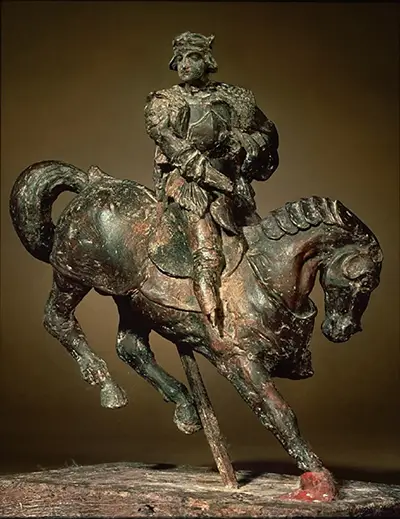Long lost to the public eye this sculpture was created in 1508 and is the only three-dimensional work known to have been credited as a da Vinci piece.
It is thought to be a liking of the French Governor of Milan, Charles d'Amboise, a patron and friend to da Vinci and likely a model for an intended larger bronze sculpture which was never made.
The face of the rider in the delicate sculpture has a striking resemblance to the portrait of Charles d'Amboise by Andrea Solario from the same period.
Lost to the World
The beeswax sculpture measures 25cm in height, 23cm in length and 9cm in width. It is believed to have been left to da Vinci's assistant Francesco Melzi along with his notebooks and effects on his death in 1519.
The sculpture remained in the Melzi family before possibly being moved to Switzerland prior to the outbreak of World War II, where it languished in a vault.
Over the years the Horse and Rider figures have suffered damage.
It was only when a group of businessmen in 1985 were looking at purchasing a museum and were shown the beeswax sculpture that it was to come back to the attention of da Vinci experts.
A Mould is Cast
After consulting foremost expert Professor Carlo Pedretti, the businessmen made a mould from the original sculpture. There are also references to the work in Da Vinci biographies and his interest in anatomy in horses is known too.
The mould along with the relevant papers was subsequently sold to Richard Lewis, a former civil engineer, who retained it for 25 years before deciding to make limited run, well-crafted bronze castings from the mould. The sale of these castings would benefit charitable causes including The Samaritans.
It is uncertain to the current whereabouts of the original beeswax sculpture of Horse and Rider. The limits of technology available to Leonardo da Vinci hindered attempts to make larger bronze sculptures including those that would have been based on his drawings.
The intricacies and precision of his work, and the perfection it sought, could not be reproduced at the time in such bronze monuments, as illustrated in his unfinished bronze statue of a horse for the Duke of Milan which would have stood 26 foot tall on completion.
Leonardo da Vinci's vast talent, displayed in an array of formats, is again shown in the intricate details of Horse and Rider.
Observed and executed in a way unfamiliar with the classical statue portrayals he would have been used to seeing, Horse and Rider reminds us of the diverse nature of da Vinci's interests.
Leonardo da Vinci not only observed to meticulous detail but wanted to understand and show how the world worked. Horse and Rider is the only known three-dimensional representation of how this fascinating mind saw the world.
